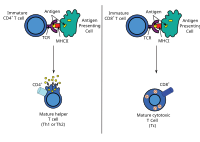Antigen presentation

Antigen presentation is like showing your parents a piece of art you made at school. Your art is the antigen and your parents are the immune cells. The immune cells need to see the art to know if it’s good or bad (harmful or harmless).
In your body, there are special cells called "antigen-presenting cells" that take pieces of the bad germs (like viruses or bacteria) that enter your body and show them to the immune cells. It's like these antigens are the bad guys and the antigen-presenting cells are the police who take pictures of them and show them to the other cops.
The antigen-presenting cell gets the bad guy (antigen) and cuts off a small piece of it, like parents take a picture of your artwork. They then carry that piece to the immune cells and show them the picture. The immune cells look at the picture and decide whether it’s harmful or not. If it is harmful, then the immune cells sound the alarm and try to get rid of it so you don’t get sick.
Overall, antigen presentation is an important process that helps your body fight off harmful germs and keeps you healthy. It's like showing pictures of the bad guys to the immune system, so it knows what to look out for to keep you safe.
In your body, there are special cells called "antigen-presenting cells" that take pieces of the bad germs (like viruses or bacteria) that enter your body and show them to the immune cells. It's like these antigens are the bad guys and the antigen-presenting cells are the police who take pictures of them and show them to the other cops.
The antigen-presenting cell gets the bad guy (antigen) and cuts off a small piece of it, like parents take a picture of your artwork. They then carry that piece to the immune cells and show them the picture. The immune cells look at the picture and decide whether it’s harmful or not. If it is harmful, then the immune cells sound the alarm and try to get rid of it so you don’t get sick.
Overall, antigen presentation is an important process that helps your body fight off harmful germs and keeps you healthy. It's like showing pictures of the bad guys to the immune system, so it knows what to look out for to keep you safe.
Related topics others have asked about:
